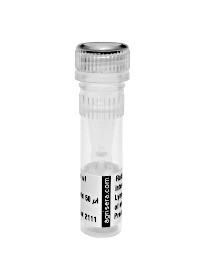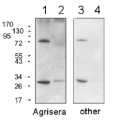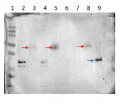1

Anti-ELF3 | Early Flowering 3
AS18 4168 | Clonality: Polyclonal | Host: Rabbit | Reactivity: Arabidopsis thaliana, Brachypodium distachyon, Oryza sativa, Solanum tuberosum
- Product Info
-
Immunogen: KLH-conjugated peptide derived from Arabidopsis thaliana ELF3, UniProt: O82804-1,TAIR: At2g25930 Host: Rabbit Clonality: Polyclonal Purity: Immunogen affinity purified serum in PBS pH 7.4. Format: Lyophilized Quantity: 50 µg Reconstitution: For reconstitution add 50 µl, of sterile water Storage: Store lyophilized/reconstituted at -20°C; once reconstituted make aliquots to avoid repeated freeze-thaw cycles.Please remember to spin the tubes briefly prior to opening them to avoid any losses that might occur from material adhering to the cap or sides of the tube. Tested applications: Chromatin Immunoprecipitation (ChIP), Immunoprecipitation (IP), Western blot (WB) Recommended dilution: 3 µl of antibody (ChIP), 3 µl of antibody used for coating 2x20 µl Dynabeads A+G (IP), 1 : 1000 (WB) Expected | apparent MW: 77 kDa - Reactivity
-
Confirmed reactivity: Arabidopsis thaliana, Brachypodium distachyon, Oryza sativa, Solanum tuberosum (leaf) Predicted reactivity: Brassica rapa, Cucurbita moschata, Corchorus olitorius, Durio zibethinus, Hevea brasiliensis, Herrania umbratica, Hordeum vulgare, Manihot esculenta, Nymphaea thermarum, Olea europaea var. sylvestris, Panicum miliaceum, Phoenix dactylifera, Pisum sativum, Populus euphratica, Prunus dulcis, Populus tremula, Ricinus communis, Solanum lycopersicum, Solanum tuberosum, Sorghum bicolor, Spinacia oleracea, Tanacetum cinerariifolium, Theobroma cacao, Trifolium pratense, Triticum aestivum, Zea mays, Vitis vinifera
Species of your interest not listed? Contact usNot reactive in: No confirmed exceptions from predicted reactivity are currently known - Additional Information
-
Additional information (application): ELF3 protein is extremely sensitive to light therefore extraction has to be done in green light and protein analysis has to be done using fresh extracts only. Even short light exposure cause degradation of ELF3. Extracted protein cannot be frozen but analysed directly following extraction.
Antibody is confirmed to work in ChIP for Oryza sativa Nippon bare.Antibody is recognizing all three isoforms in tomato:
Solyc08g065870.4.1: Theoretical pI/Mw: 8.71 / 70659.09 DaSolyc11g070100.2.1: Theoretical pI/Mw: 8.94 / 66714.77 DaSolyc12g095900.2.1: Theoretical pI/Mw: 8.80 / 79108.57 Da - Background
-
Background: ELF3 (Early Flowering 3) is a transcription factor, which acts within a 'zeitnehmer' feedback loop and is involved in its own circadian regulation and is a part of a corepressor complex consisting of ELF4, ELF3, and LUX involved in the transcriptional regulation of APRR9. The activity of the protein may be decreased in long day conditions due to its interaction with phytochrome B (phyB). ELF3 is also involved in responses to nematode parasitism.
Alternative names: Nematode-responsive protein - Product Citations
-
Selected references: Malakar et al. (2025). BBX24/BBX25 antagonizes the function of thermosensor ELF3 to promote PIF4-mediated thermomorphogenesis in Arabidopsis. Plant Commun. 2025 May 28:101391.doi: 10.1016/j.xplc.2025.101391.
Gao et al. (2023). Phytochromes transmit photoperiod information via the evening complex in Brachypodium. Genome Biol. 2023 Nov 7;24(1):256. doi: 10.1186/s13059-023-03082-w.
Seo et al. (2023) ZTL regulates thermomorphogenesis through TOC1 and PRR5 [published online ahead of print, 2023 Jan 19]. Plant Cell Environ. 2023;10.1111/pce.14542. doi:10.1111/pce.14542
Andrade, Lu, Cordeiro, et al. (2022) The evening complex integrates photoperiod signals to control flowering in rice. Proc Natl Acad Sci U S A. 2022;119(26):e2122582119. doi:10.1073/pnas.2122582119
Andrade et al. (2022) The evening complex integrates photoperiod signals to control flowering in rice. Proc Natl Acad Sci U S A. 2022 Jun 28;119(26):e2122582119. doi: 10.1073/pnas.2122582119. Epub 2022 Jun 21. PMID: 35733265; PMCID: PMC9245669. - Protocols
-
Agrisera Western Blot protocol and video tutorials
Protocols to work with plant and algal protein extracts
Oxygenic photosynthesis poster by prof. Govindjee and Dr. Shevela
Z-scheme of photosynthetic electron transport by prof. Govindjee and Dr. Björn and Dr. Shevela - Reviews:
-
This product doesn't have any reviews.



